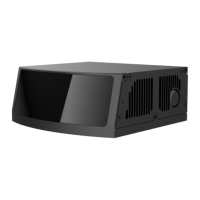B.2.3 Parameters
This project has only one parameter file config.yaml, which is stored in the
rslidar_sdk/config folder. The entire parameter file can be divided into two parts, a common
part and a LiDAR part. In the case of multiple LiDARs, the common part parameters are
applicable to all LiDAR sensors, where the LiDAR part parameters need to be set
separately according to the actual status of each LiDAR.
Note: The parameter file config.yaml has strict requirements for indentation! Please
ensure that the indentation at the beginning of each line remains consistent after modifying
the parameters!
B.2.3.1 Common Part Parameters
This part of parameters is used to set the message source of the LiDAR and decides
whether to publish the results.
common:
msg_source: 1 # LiDAR message source type
send_packet_ros: false
send_point_cloud_ros: false
send_packet_proto: false
send_point_cloud_proto: false
pcap_path: /home/robosense/lidar.pca #Absolute address when playing offline
PCAP packets
msg_source:
1 -- Connect to LiDAR online. For more details, please refer to Reading LiDAR data
online and sending to ROS.
2 -- Parse ROS or ROS2 packets offline. For more details, please refer to Recording ROS
data packets & parsing ROS data packets offline.
3 -- Parse the pcap packet offline. For more details, please refer to Parsing Pcap packets
offline and sending to ROS.
4 -- The LiDAR message source is the packet message of Protobuf-UDP
5 -- The LiDAR message source is the point cloud message of Protobuf-UDP
send_packet_ros:
true-- LiDAR packet messages will be sent through ROS or ROS2, false-- forbidden.
Since the LiDAR ROS packet message is a custom ROS message of RoboSense,
users cannot directly echo the topic to view the specific content of the message. In fact,
the packet is mainly used to record offline ROS packets, because the volume of the packet
is smaller than the point cloud.
send_point_cloud_ros:
true – LiDAR point cloud message will be sent through ROS or ROS2, false—forbidden.
The point cloud message type is officially defined by ROS as
sensor_msgs/PointCloud2, so users can directly use Rviz to view the point cloud. At the
same time, users can also choose to record the point cloud directly when recording the
packet, but the volume of the packet will be very large, so we recommend recording the

